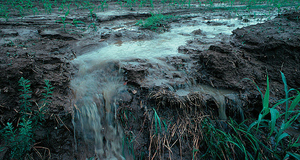Featured Article:Theoretical Utilisation of Biological Warfare from Aquatic Invasive Species
By
2017, Vol. 9 No. 11 | pg. 3/3 | « ConclusionMy research suggests that current UK legislation is not robust, concise or flexible enough to handle the threat posed by invasive aquatic species. The biggest issue seems to stem from the lack of dedicated environmental courts run by suitably qualified environmental lawyers, which has caused all environmental cases to go through normal civil and criminal courts where uncertainty exists on current legislation, environmental concepts, mass victimization with regards to causation, and a lack of economic restitution or compensation schemes. Although the prosecution of cases involving accidental and reckless maritime pollution incidents are common, there is a distinct lack of prosecutions in cases of malicious intent. Those individuals or companies that do maliciously cause maritime pollution don’t advertise their activities because of economic self-interest and are only caught due to their own complacency. The IMO has publicly stated that they have neither the mandate nor the resources to enforce environmental standards, and whilst in the UK the Environment Agency tries to enforce environmental law and deter offenders with fixed penalty fines the truth is that no organisation has the operational power necessary to catch would be polluters, either due to a failing of their management policies or because of insufficient resources and manpower.Before I started this project it would have been the case that many malicious activities could have taken place due to failings in international laws, a general apathy among port states and their subsequent lack of inspections, and the lack of specialist technologies required for safe ballast water management. However, since the ratification of the Ballast Water Management Convention due to the actions of Finland, it has now become likely that these failings will be solved or at least mitigated in the years to come. Accidents will still happen due to technology failures, operational necessity, or human failings of over-confidence, recklessness, negligence or complacency. Malicious activities would still continue but would require greater planning, their actions would have to take into account more active port states due to more stringent legislation and policy initiatives being invoked. Vessels would be inspected more regularly, correct training and documentation of personnel would exist, and ships would have to comply with international regulations on ballast water technologies. However this could make the detection and enforcement of malicious activities harder, as offenders would operate using smaller vessels and only target smaller ports that don’t have the resources or facilities required to stop an incident. I have clarified though my research that although invasive aquatic species meet the requirements for potential biological weapons, their use could never be classed as terrorism. The criteria for terrorism has not been met as although there is the potential to physically injure people through the use of pathogens, and cause irrevocable damage to property from micro-organisms, there is a distinct lack of social or political motivation and no inherent fear or terror caused by its use. From my primary research I can infer that most people are environmentally conscious in their local communities with 90% doing recycling or volunteering with local charities. 95% said they knew that governments were not doing enough to combat the spread of invasive species, however only 5% were willing to do anything other than provide non-vocal or passive support. However a contingent valuation gave me a reported £3.32B pounds to support the cause of eradicating invasive species from the UK. My project is important to researchers and practitioners who want a specialist overview of maritime and environmental legislation or biological weapons from an invasive species perspective, and for anyone who wants to know the potential strengths or weakness of the current legislative process from detection to enforcement. It will also be useful for those wanting to know the current public attitudes to environmental affairs and their likely economic expenditure. My future research would focus on expanding each of my literature sections, and to conduct a comparative study of both United States and New Zealand legislation, both countries being leadersregarding invasive species management. I would also expand my case study to encompass other scenarios and delve deeper into the legislative process, its implementation, its failings, and the cases themselves so that I could round off my knowledge and skills. ReferencesAtiyah, P.S. Rise and Fall of Freedom of Contract. 1979. Baatz, Y., Velasco, A.C., et al. Maritime Law. Sweet and Maxwell, London. 2011. Baughen, S. Shipping Law, (5th ed.), pp: 316-330. Routledge, England. 2012. Beckman, J. Comparative Legal Approaches to Homeland Security and Anti-Terrorism. Ashgate Publishing, England. 2007. Beder, S. Environmental Principles and Policies: An Interdisciplinary Introduction. Earthscan, London. 2006. Bell, S., McGillivray, D. Environmental Law (8th ed.), Oxford University Press. 2013. Beyerlin, U., Marauhn, T. International Environmental Law. Hart Publishing Ltd, Oxford. 2011. Bingham, N., Blowers, A., Belshaw, C. Contested Environments. John Wiley & Sons Ltd, Chichester. 2003. Bjorn, K. International Maritime Organisation & World Maritime University Global Research & Development Forum on Emerging Ballast Water Management Systems. Wallin & Dalholm Boktryckeri, Sweden. 2010. Blowers, A., Hinchliffe, S. Environmental Responses. John Wiley & Sons Ltd, Chichester. 2003. Booy, O., Wade, M., White, V. Invasive Species Management for Infrastructure Managers and the Construction Industry. CIRIA. Latimer Trend, Plymouth. 2008. Boyle, A.E. Marine Pollution under the Law of the Sea Convention. 79 AJIL347. 1985. Burek, C.V. The role of the voluntary sector in the evolving Geoconservation movement. Geological Society: Special Publication 300. pp61-89. MPG Books Ltd, England. 2008. Burek, C.V., Prosser, C.D. The History of Geoconservation. Geological Society: Special Publication 300. MPG Books Ltd, England. 2008. Caddell, R., Thomas, R. Shipping, Law and the Marine Environment in the 21st Century. Lawtext Publishing. 2013. Carlton, J.T. Transoceanic and Interoceanic Dispersal of Coastal Marine Organisms. The Biology of Ballast Water. Oceanographic Marine Biology Annual Review 23, pp313-372. 1985. Churchill, R.R., Lowe, A.V. The Law of the Sea. (3rd ed.), Manchester University Press, Manchester. 1999. Clark, C.W., Jager, J., Eijndhoven, J.V. Learning to Manage Global Environmental Risk: Managing Global Environmental Change. MIT Press, London-Massachusetts. 2010. Dandu, P. Ballast Water Management - An Overview of the Regulatory Process. Wallin & Dalholm Boktryckeri, Sweden. 2010. Dandu, et al. Review of emerging risks from ballast water treatment. Chemosphere Journal, 122 (10), 2014. Dennison, W.C. Environmental Problem Solving in Coastal Ecosystems: A Paradigm Shift to Sustainability. Estuarine, Coastal and Shelf Science 77, pp185-196. ScienceDirect, University of Maryland, USA. 2007. DHS. Diversity in the Air, Astrobiology, Department of Homeland Security, USA. 2006. Dobbs, F., Rogerson, A. Ridding Ships Ballast Water of Micro-organisms, Environmental Science and Technology 6, pp259-264. 2005. Dobson, A. Biosecurity: Socio-politics of Infectious Disease. Routledge, England. 2013. Drake, L.A., Doblin, M.A. Potential Microbial Bio-Invasions via Ships Ballast Water, Sediment, and Biofilm. Marine Pollution Bulletin 55. 2007. Duffy, H. The War on Terror and the framework of International Law. (2nd ed.), Cambridge University Press, England. 2015. Elliot, J. Wildlife Toxicology – forensic approaches. Springer, USA. 2011. Falk, I. Managing Biosecurity across Borders. Springer, USA. 2011. Farmer, A. Managing Environmental Pollution. Routledge, England. 1997. Farrall, S., Ahmend., T., French, D. Criminological and Legal Consequences of Climate Change. Hart Publishing, Oregon. 2012. Faure, M., Skogh, G. The Economic Analysis of Environmental Policy and Law. Edward Elgar Publishing Ltd, England. 2003. Faure, M.G., Lixin, H., Hongjun, S. Maritime Pollution Liability and Policy: China, Europe and the US. Kluwer Law International Journal Collection for Energy and Environment Law & Policy Series 13. Kluwer Law International, Netherlands. 2010. Finch, E., Fafinski, S. Tort Law. (5th ed.), Pearson Education Ltd, England. 2015. Fitzmaurice, M. Contemporary Issues in International Environmental Law. Edward Elgar Publishing Ltd, England. 2009.
Franklin, D., Hawke, N. Pollution in the UK. Sweet and Maxwell, London. 1995. Gillespie, A. International Environmental Law, Policy, and Ethics. (2nd ed.), Oxford University Press, England. 2014. Gordh, G. Plant Biosecurity Principles – Agriculture. Springer, USA. 2013. GTD. Global Terrorism Database. Accessed online on 15/08/2016. https://www.start.umd.edu/gtd/ Hakapaa, K., Molenaar, E.J. Innocent Passage – Past and Present. Marine Policy Journal 23 (2): pp131-45. Elsevier Science Ltd, England. 1999. Hall, M. Victims of Environmental Harm: Rights, Recognition, and Redress under National and International Law. Routledge, New York. 2013. Hamilton, D. Predation of Zebra Mussels by Diving Ducks: An Enclose Study. Ecology 75: pp521-31. 1994. Hancock, J. Environmental Human Rights - Power, Ethics, and Law. Ashgate Publishing Ltd, England. 2003. Hassan, D. Protecting the Marine Environment from Land-Based Sources of Pollution – Towards Effective International Cooperation. Ashgate Publishing Ltd, England. 2006. Hedemann-Robinson, M. Enforcement of European Union Environmental Law: Legal Issues and Challenges. Routledge & Cavendish Publishers, England. 2007. Herber, H. Invasion Biology and Ecological Theory. Cambridge University Press, England. 2014. Hill, C., Soehring., et al. Arrest of Ships. Lloyd’s of London Press Ltd. 1985. Hilson, C. Regulating Pollution: A UK and EC Perspective. Hart Publishing Ltd, Oregon. 2000. Hinchcliffe, S., Blowers, A., Freeland, J. Understanding Environmental Issues. John Wiley & Sons Ltd, Chichester. 2003. Hu, N.T.A., McDorman, T.L. Maritime Issues in the South China Sea. Routledge, New York. 2013. Huat, T.Y. BWM Hurdles and the Need for Innovative Approaches: An Industry Perspective. Wallin & Dalholm Boktryckeri, Sweden. 2010. Huber, M., Liberatore, A. Learning to Manage Global Environmental Risk: A Regional Approach to Management of Global Environmental Risks - The Case of the European Community. MIT Press, London-Massachusetts. 2010. Jackson, D.C. Enforcement of Maritime Claims, (4th ed.), Informa Professional, England. 2005. Jarvis, J.P. Ecological Principles and Environmental Issues. Pearson Education Limited, England. 2000. Jones, S. Maritime Security: A Practical Guide. The Nautical Institute, London. 2006. Kachel, M.J. Particularly Sensitive Sea Areas: The IMO’s Role in Protecting Vulnerable Marine Areas. Springer-Verlag Heidelberg, Germany. 2008. Kirkman, R. The Ethics of Metropolitan Growth – the future of our built environment. Continuum International Publishing Group, England. 2010. Klein, N. Maritime Security and the Law of the Sea. Oxford Monographs in International Law. Oxford University Press Inc, New York. 2011. Kjerfve, B. IMO-WMU Global R&D Forum on Emerging Ballast Water Management Systems. Wallin & Dalholm Boktryckeri, Sweden. 2010. Kyriacou, S. Ballast Water Management Conference: Technologies, Challenges and Solutions by Wartsila Environmental Solutions. Warsash Maritime Academy, England. 2015. Leib, L.H. Human Rights and the Environment: Philosophical, Theoretical, and Legal Perspectives. Martinus Nijhoff Publishers, Leiden. 2011. Lloyds. International Maritime and Commercial Law Yearbook. Informa Professional. 2003-2009. Loomis, J. Economic Values without Prices, the Importance of Non-Market Values and Valuation for informing Public Policy Debates. Choices Magazine, 3rd Issue, 20 (3). 2005. Louka, E. International Environmental Law: Fairness, Effectiveness, and World Order. Cambridge University Press, England. 2006. Lucas, P.H., Phillips. Protected Landscapes: A guide for Policy-Makers and Planners. Chapman & Hall, London. 1998. MacEwen, A., MacEwan, M. A Cosmetic Conservation System. John Willey & Sons Ltd, New York. 1982. Macrory, R. Principles of European Environmental Law: Principles of the Avosetta Group of European Environmental Lawyers. Europa Law Publishing, Sweden. 2004. Mansell, J.H.K. Flag State Responsibility: Historical Development and Contemporary Issues. Springer-Verlag Berlin Heidelberg, Germany. 2009. Marcel, V., Cato, T.H. Ballast Water Treatment Systems: Old and New Ones. Wallin & Dalholm Boktryckeri, Sweden. 2010. Marques, R.C. Regulation of Water and Wastewater Services: An International Comparison. IWA Publishing, London. 2010. Martin, G. Understanding Terrorism: Challenges, Perspectives and Issues. pp4-6, 267-331. SAGE Publications Ltd, California State University, London. 2010. McConnel, M.L., Gold, E. The Modern Law of the Sea: Framework for the Protection and Preservation of the Marine Environment. Case Western Reserve Journal of International Law 23, pp83-105. 1991. McEldowney, J.F. Environmental Law and Regulation. Blackstone Press, London. 2001. McNeely, J.A. Protected areas for the 21st century: Working to provide Benefits to Society. Journal of Biodiversity and Conservation 3 (5). Chapman & Hall, Switzerland. 1994. McNicolas, M. Maritime Security: An Introduction. Elsevier, Oxford. 2008. Mejia, M.Q., Kojima, C. Piracy at Sea. WMU Studies in Maritime Affairs Book 2. Springer-Verlag Heidelberg, Germany. 2013. Michael, G.P. The Variable Buoyancy Ship: A Road to the Elimination of Ballast. Wallin & Dalholm Boktryckeri, Sweden. 2010. Millett, P.M.A. The Encyclopaedia of Forms and Precedents (5th ed.), Public Health and Environmental Law Rating and Similar Charges 32, Butterworths & Co, England. 1992. Millett, PMA. The Encyclopaedia of Forms and Precedents (5th ed.), Shipping, Solicitors, Stock Exchange & Telecommunications 39, Butterworths & Co, England. 1992. Molenaar, E.J. Managing Biodiversity in Areas Beyond National Jurisdiction. International Journal of Marine and Coastal Law, 22(1:4), pp89-124. 2007. Mooney, H. Invasive Species in a Changing World. Island Press, USA. 2001. Morris, D., Freeland, J., Hinchcliffe, S., Smith, S. Changing Environments. John Willey & Sons Ltd, Chichester. 2003. Mukherjee, P.K., Brownrigg, M. Farthing on International Shipping. WMU Studies in Maritime Affairs Book 1, (4th ed.), Springer-Verlag Heidelberg, Germany. 2013. Murphy, M.N. Contemporary Piracy and Maritime Terrorism: The threat to International Security. Routledge, Oxford. 2007. Nalepa, T. Quagga and Zebra Mussels. CRC Press, USA. 2012. Nash, C.N. Latin Nations Feud over Cholera Outbreak. New York Times, USA. 1992. Accessed online on 17/09/2016 at http://www.nytimes.com/1992/03/10/world/latin-nations-feud-over-cholera-outbreak.html Navrud, S., Ready, R. Environmental Value Transfer: Issues and Methods. Dordrecht, Springer. 2007. Naylor, T.P. Maritime Tankers: Terrorist Threats, Consequences and Protective Measures. Nova Science Publishers Inc. New York. 2009. NOAA Fisheries Service. Ballast Water – A Pathway for Aquatic Invasive Species, USA. 2013. NSCA. Pollution Handbook: The Essential Guide to UK and European Pollution Control Legislation. 1995. Parsons, M.G. The Variable Buoyancy Ship: A Road to the Elimination of Ballast. Wallin & Dalholm Boktryckeri, Sweden. 2010. Pearce, F. How the Soviet Seas Were Lost, New Scientist 11, pp38-42. 1995. Pearce, F. Dead in the Water, New Scientist, pp26-31. 1995. Pearce, F. All-Out War on the Invader, New Scientist 3, pp34-38. 1998. Pearce, F. The New Wild: Invasive Species will be Natures Salvation. Icon Books Ltd, London. 2015. Pennington, M. Conservation and the Countryside: By Quango or Market? IEA Studies on the Environment 6. Goron Pro-Print Co Ltd, London. 1996. Perrings, C. Bio-invasions and Globalisation, Ecology & Economics. Oxford University Press, England. 2010. Pettigrew, W. Conservation in Action. Geographical Magazine 55 (6), pp313-315. Royal Geographical Society, London. 1983. Pimental, D. Biological Invasions – Economic & Environmental Costs. Springer, USA. 2008. Prasad, S.K. Biological Agents (2). Discovery Publishing House. 2009. Prosser, C.D. The History of Geo-conservation in England: Legislative and Policy Milestones. Geological Society: Special Publication 300, pp113-122, MPG Books, England. 2008. Pugh, C., Day, M. Toxic Torts. Cameron May Ltd, London. 1992. Pughiuc, D. Ballast Water Management: An Overview of the Regulatory Process. Wallin & Dalholm Boktryckeri, Sweden. 2010. Rakibul, H. Biological Weapons: Covert Threats to Global health Security. Asian Journal of Multidisciplinary Studies. 2(9). 2014. Ready, R., Navrud, S. Benefit Transfer: The Quick, the Dirty, and the Ugly. Choices Magazine, 3rd Issue. ScienceDirect. 2005. Rilkov, G. Biological Invasions in Marine Ecosystems. Springer, USA. 2010. Roach, J.A. Initiatives to Enhance Maritime Security at Sea (28). Marine Policy (41). 2004. Roberts, J. Marine Environment Protection and Biodiversity Conservation: The Application and Future Development of the IMO’s Particularly Sensitive Sea Area Concept. Springer-Verlag Heidelberg, Berlin. 2007. Rothwell, D.R., Stephens, T. The International Law of the Sea, (2nd ed.), Hart Publishing, London. 2016. Rue, C.D.L. Liability for Damage to the Marine Environment. Lloyd’s of London Press Ltd, London. 1993. Rue, C.D.L., Anderson, C.B. Shipping and the Environment, (2nd ed.), Informa Law, London. 2009. Saul, B. Defining Terrorism in International Law. Oxford Monographs in International Law. Oxford University Press, England. 2006. Seebens, H., et al. The Risk of Marine Bio-invasion caused by Global Shipping, Ecology Letters 16 (6) pp782-90. 1986. Shearer, I.A. Problems of Jurisdiction and Law Enforcement against Delinquent Vessels. International and Comparative Law Quarterly 35(2:4), pp320-43. 1986. Simberloff, D. Invasive Species – What We Need To Know. Oxford University Press, England. 2013. Slavikova, L. From Cost Benefit to Institutional Analysis in the Economics of the Environment. Contemporary Economics 7 (2). 2013. Sneddon, S. Environmental Law (4th ed.), Law Express. Pearson Education Ltd, England. 2013. Soyer, B., Tettenborn, A. Pollution at Sea: Law and Liability. Informa Law, England. 2012. Stevens, T. Can stated Preference Valuations help improve Environmental Decision Making? Choices Magazine, 3rd Issue. ScienceDirect. 2005. Tan, A.K.J. Vessel-Source Marine Pollution: The Law and Politics of International Regulation. Cambridge University Press, Cambridge. 2006. Tey, Y.H. BWM Hurdles and the need for Innovative Approaches: An industry Perspective. Wallin & Dalholm Boktryckeri, Sweden. 2010. Tickner, J., Gouveia-Vigeant, T. The 1991 Cholera Epidemic in Peru: Not a Case of Precaution Gone Awry. Journal of Risk Analysis, 25 (3), 2005. Tsimplis, M.N. Shipping in the Marine Environment in the 21st Century: Maritime Law Evolution. Hart Publishing, Oxford. 2013. Turner, S.J. A Substantive Environmental Right. An Examination of the Legal Obligations of Decision Makers towards the Environment. Wolters Kluwer, New York. 2009. USGS. Zebra Mussels Report – Great Lakes Science Centre, US Geological Society, USA. 2014. Vanderzwagg, D.L., Powers, A. The Protection of the Marine Environment from Land-based Pollution and Activities: Gauging the Tides of Global and Regional Governance. International Journal of Marine and Coastal Law 23 (3:9), pp423-52. 2008. Veldhius, M. Hallers, C.T. et al. Ballast Water Treatment Systems: Old and New Ones. Wallin & Dalholm Boktryckeri, Sweden. 2010. Warren, A., Goldsmith F.B. Conservation in Perspective. John Willey & Sons Ltd, New York. 1983. Wilde, M. Civil Liability for Environmental Damage: A Comparative Analysis of Law and Policy in Europe and the United States. Kluwer Law International, The Hague. 2002. Williams, P., Wallace, D. Unit 731: Japan’s Secret Biological Warfare in World War II. 1989. Woods, M. Rural Geography. Sage Publications Ltd, London. 2005. Wynne, B., Simons, P. Learning to Manage Global Environmental Risks. Institutional Cultures and the Management of Global Environmental Risks in the United Kingdom. MIT Press, London-Massachusetts. 2010. Zacharias, M. Marine Policy – An introduction to governance and international law of the oceans. Routledge, New York. 2014. Zaitsev, Y., Alexandrov, B.G. Recent Man-Made Changes in the Black Sea Ecosystem, NATO ASI Series. Kluwer Academic. Dordrecht, Netherlands. 1997. Technical Abbreviations
Endnotes1.) Tickner, J., Gouveia, T. The 1991 Cholera Epidemic in Peru: Not a Case of Precaution Gone Awry, 2005. 2.) Nash, C.N. Latin Nations Feud over Cholera Outbreak, 1992. 3.) The discharge might have been deliberate in order to test the concept of pathogen delivery. If this had happened simultaneously in various and strategic locations, it would lead to emergency and social services and medical facilities becoming paralysed, which would be ideal for creating confusion and panic that would overwhelm authorities in lieu of another form of attack. Author Speculation. 4.) Environmental law is a relatively new concept which has had to combine philosophy, economics, property, and insurance, public, comparative and EU law in order to be relevant and effective. 5.) A process caused mainly due to agricultural practices where the biodiversity balance is disrupted in still or slow moving water. Fertilisers are leached through the water table instead of being absorbed by the crops due to the excessive amounts used in order to combat potential run-off due to rain, which provides local algae a massive influx of nutrients causing exponential growth. The algae then spreads over the surface of the water body effectively cutting off all light to the water below. Without light the underwater plants are the first to die which causes either due to lack of available oxygen (hypoxia), or lack of food the demise of all aquatic life. Once all life has been terminated the algae burns itself out due to lack of nutrients, and the waters become the epitome of decay and stagnation. Carlton. 1985. 6.) Originally due to monarchist roots in the form of an unwritten constitution which was introduced by Alfred the Great, the constitution would steadily grow and expand due to the Norman invasion of 1066, and the Magna Carta in 1215 with it finally being established as statute law in 1297. 7.) Roman and Druid cultural, religious and hierarchical beliefs governed the population. Gavouneli, M. 1995. Shelton, D. 1991. McIntyre, A.D. 1995. Kiss, A.C. 1991. 8.) Its arrival would create a new era, the advent of the machines and large scale manufacturing. It would rapidly expand slow processes including chemical and natural resource manufacturing, and it would increase the spread and usage of steam technology into the rail and maritime industries which provided for the latter no greater speed but infinitely more reliable power than wind energy. 9.) Although at the time, concern was only over the public health issues of its users, not the environment to be protected. Modern day examples can include; acid rain from UK industries that damaged Scandinavian forests and fisheries during the 1970s, and the 1986 Chernobyl disaster which caused low level radiation poisoning in Welsh sheep. (RCEP) 10.) Wilde, M. Civil Liability for Environmental Damage. 2002. 11.) Global issues that were in the public’s view were solved including stratospheric ozone degradation due to CFCs during the 1997 Montreal Protocols. Murray. 2003. & Liffin. 1994. 12.) Research was shaped on current technological advances, in the 1950’s physics was at the forefront of research, by the 1980s it had become ecology, and by the turn of the millennium it was centred on conservation. Young. 1999., Levy. 1996., Rowlands. 1995. & Desai. 1998. 13.) Clark, C.W et al. Learning to Manage Global Environmental Risk, 2010. 14.) Came into being due to the Environment Protection Act 1990 and the Environment Act 1995. 15.) Example: Cyclists and walkers gain a positive boost due to minimising their impact on the environment. However; they get increased social stigma, hostility from drivers and higher potential for personal injury. Their personal contribution is inconsequential as pollution levels stay virtually consistent and in fact is detrimental to their health and well-being. Similarly organisations and companies will prioritise economics over environmental concerns, undercutting more forward thinking companies by the balancing of probabilities of getting caught against possible fines and negativity. 16.) Any environmental activity that results in injury, illness or death breaches human rights. This law was introduced in 1948, but over 12,000,000 people still die each year due to contaminated water. Beder. 2006. 17.) This was due to the failure of the 1957 Treaty of Rome, which had successfully established the European Economic Community but also failed to impose a unified structure for environmental management, strategies or legislation. This led each nation to create their own frameworks which were impossible to implement or integrate on an international basis. The Geneva Convention sought to integrate maritime laws and conventions with the environment, which it did. However like most international discussions they failed to reach a consensus on whether to focus on conservation or resource utilisation as the gain of one was counterproductive to the other, and also whether constraints should be legalised or just remain as empowered discretion on the part of the nation affected. Gold, E. 1997. 18.) An emergency session of the UN General Assembly agreed that environmental deterioration had reached a detrimental level. Unga/res/2398(xxiii). Gillespie. 2014. 19.) Soft Laws were introduced similar to the maritime (COSWOP) code of safe working practices, which was designed as best industrial practices, guidance and deference. The initial concept was introduced as the Polluter Pays Principle and utilised the Latin concept of (sic utere tuo ut alienium non laedas) which translates out as the principle of good neighbourliness, abuse of rights, and the concept of custodianship and was implemented initially to provide economic cooperation and development against the unfair pollution control subsidies which were giving a competitive advantage for large organisations within the international trade market. This also led to the organisational changes within the international environmental action programs due to the 1973 Waters Act and adoption of environmental impact assessments within the industrial sectors against any detrimental environmental concerns, the protection of wildlife, and natural habitats. Birnie. 1997. 20.) UNCLOS is the United Nations Convention on the Law of the Sea which aims to protect and preserve the marine environment, natural resources, and maritime industrial businesses. The IMO is used as a negotiating forum, and is exceptional and unparalleled in its devotion for implementing international legislation, often hampered in its attempts due to the reluctance and inability of flag states to implement laws, train personnel and improve infrastructure. Tsmiplis, 2013. 21.) This convention was a direct response to the terrorist seizure of the Italian cruise ship Achille Lauro in 1985, and increased public pressure on governments to enforce policies leading to the USA convicting half of environmental crimes with jail terms, whilst New Zealand instituted million dollar fines. The PPP was expanded to include accidental damage, although it has been argued that it was only ever introduced to protect international trade rather than any deep seated urge to protect the environment. 22.) International laws can be enforced over an individual nation’s own legislation provisions, if the pollution or damage interferes or has the potential to interfere with others. Also introduced was the idea of marine protected areas at the Earth Summit which caused major controversy as varying levels of protection were now afforded to the environment, which placed restrictions on the principles of innocent passage and free navigation. Roberts, J. 2007. 23.) Convention designed to provide liability for damage resulting from activities dangerous to the environment, a continuation of work from the Council of Europe. Also in 1995 amendments were made to the MSA and the ISPS code. Louka. 2006. 24.) The Ballast Water Management Convention which started in 2004 is finally ratified by Finland in 2016, and will come into force in 2017 and also reinforced EU approved legislation banning the possession, transport and sale of invasive species that are deemed a concern worldwide. 25.) Carlton, C.W. Learning to Manage Global Environmental Risk. 2010. 26.) Which also added regulations over dumping and effluent. 27.) 44% comes from land, 33% from air, and 10% from dumping. 28.) Under UNCLOS art 19(2)(h)., although Boyle counters that they are only empowered to regulate pollution incidents within their remit, rather than being required to, which basically means that it is up to the flag state to decide whether they want to force the issue. Boyle, A.E. Marine Pollution under the Law of the Sea Convention. 1985. (Further details can be found in later sections in ports/flags of convenience). 29.) This because although UNCLOS provided bonuses to their nominal subscribed powers, they have actually only maintained their enforcement powers which were limited to start with. 30.) Churchill and Lowe. The Law of the Sea. 1999. 31.) UNCLOS art 211(3) anticipates that states will establish particular requirements for the prevention, control, mitigation and judgments on pollution matters of the maritime environment as a prerequisite for entry of said FS vessels into their ports and internal waters, with failure to comply with local legislation resulting in expulsion or detainment for not complying with other international legislation such as MARPOL or SOLAS. 32.) In the same way that flags of convenience has increased so that vessels can avoid the financial obligations, environmental standards and legal requirements of a stringent flag state, and instead make use of states with lesser standards, so too are ports of convenience increasing as they offer less financial and legal constraints on their practices, as well as less inspections, and therefore potential black listing. 33.) Mansell, J.H.K. Flag State Responsibilities. 2009. 34.) Invasive Species are defined as any organism that is displaced from its endemic environment, and by whatever means is thusly distributed to new ecosystems, whereby the organism becomes invasive either due to lack of predators, increased food supply, or better living conditions, and thus thrives in such a way that the indigenous organisms are out competed and rapidly decline. 35.) Tey, Y.H. BWM Hurdles and the need for Innovative Approaches, 2010. 36.) Findings from the International Geosphere Biosphere Programme. 2001. 37.) Pearce, F. The New Wild: Invasive Species will be Natures Salvation, 2015. 38.) During the Black Death over 75,000,000 people died due to an IS which originated in Asia in the form of bubonic plague carried by black rats. Modern examples include Chinese Mitten Crabs in Europe, Dinoflagellates causing Red Tides across the world and Asian Kelp in Australia. 39.) Seebens, H, et al. The Risk of Marine Bio-invasion caused by Global Shipping, 2013. 40.) Forced people to stop the spread of invasive plants, although a loop hole allowed for people to still cultivate them for personal reasons. 41.) Controlled the import of non-native fish by implementing a series of licenses and regulatory hurdles for ownership. 42.) Section 9 states that it is illegal to release or allow to escape any non-native species, and prohibits the sale of high risk invasive species. 43.) Although not an issue for IAS, it restricted the means in which IS could be killed, which actually harmed the anti-IS movement. A counter-productive law that actually increased the rate of environmental ecosystem loss due to the restrictions. No burning, drowning, suffocating, crushing, impaling, stabbing, exploding etc. R (on the application of Murray) v. Derbyshire county council, CO/1493/2000. The times, 8 Nov 2000 common. Hancock, 2003. 44.) www.plantright.org/sites/default/files/Water_hyacinth,%20WikiCommons,%20Ted%20Center-USDA.jpg 45.) .www.freep.com/story/news/local/michigan/2014/11/11/seven-invasive-species-banned-michigan-killer-shrimp/18822759/ 46.) http://www.bbc.co.uk/news/uk-wales-south-west-wales-21227831 47.) https://gardenofeaden.blogspot.co.uk/2011/08/how-to-catch-crayfish.html 48.) www.torfaen.gov.uk/en/LeisureParksEvents/NatureAndConservation/Gianthogweed/Gianthogweed.aspx 49.) https://www.tumblr.com/search/american-mink 50.) www.telegraph.co.uk/gardening/problem-solving/everything-you-need-to-know-about-japanese-knotweed/ 51.) http://ywt-data.org/inns-mapper/species/floating-pennywort 52.) Prickly Pear Cactus was a minor irritant compared to its introduced predator the Argentine Cactus Moth which not only thrived on the cactus but caused widespread lasting damage to the introduced areas, showing the unforeseen side effects of species introduction. 53.) Biological weapons is not a new concept in warfare, having been conceived throughout history for use against cities under siege. Rotting meat, dead bodies (especially lepers) and other foul smelling detritus would be catapulted into an enemy’s base to spread terror and potential diseases either to weaken or kill. The use of fungi was used to poison wells, and the Romans salted the earth to destroy any potential for crops which would also have a detrimental effect on their enemies. Hasan, E. Biological Weapons: Covert threats to Global Health Security. Technological sophistication lead to the production of germ theory and the use of anthrax and glanders was used in WW1 by Germany with indifferent results. Prasad, S.K. Biological Agents (2). The Geneva Protocol of 1925 prohibited their use. However although they never used them, Paul Fildes on approval of Winston Churchill effectively weaponised anthrax, tularemia, and botulism. Imperial Japan managed to bombed Chinese cities in 1940 with ceramic bombs filled with bubonic plague carrying fleas, although they were ineffective due to the inefficient delivery system still managed to kill 400,000 people. Williams, P., Wallace, D. Unit 731: Japan’s Secret Biological Warfare in World War II. 54.) GTD. Global Terrorism Database, 2016. 55.) Saul, B. Defining Terrorism in International Law, 2006. 56.) Similar to the release of rabbits in Australia, and the fictional Star Trek creature known as the 'Tribble'. 57.) Zaitsev, Y., Alexandrov, B.G. Recent Man-made Changes in the Black Sea Ecosystem, 1997. 58.) https://commons.wikimedia.org/wiki/File:Mnemiopsis_leidyi_-_Oslofjord,_Norway.jpg 59.) £100k damage occurred for water works modification in Killyhevlin, Ireland. Also costs the UK around £2B per annum, and the UK Biodiversity minister Joan Ruddock stated it as the 2nd greatest threat to biodiversity after habitat destruction. 60.) Hamilton, D. Predation of Zebra Mussels by Diving Ducks, 1994. 61.) USGS. Zebra Mussels Report – Great Lakes Science, 2014. 62.) http://www.corpi.ku.lt/databases/index.php/aquanis/species/view/id/1136 63.) United Nations, 2004. 64.) Dandu, et al. Review of Emerging Risks from Ballast Water Treatment, 2014. 65.) These include; filtration, cyclonic separation, heat treatments, flush through, microwaves, ultra-violet, mechanical abrasion, electrocution, cavitation, pressure waves and normal chemical methods. 66.) Small Crustaceans that eat plankton where the diseases normally thrive. They are the initial food source for carnivores, and are found in virtually every water habitat. A picture of one can be seen just under my name on the title page. 67.) DHS. Diversity in the Air, 2006. 68.) However not every breach of environmental law will constitute a maritime security threat, only the potential for all cases being such, and of a particular scale. See UN Report of the Secretary General: Oceans and the Law of the Sea (10 March 2008) UN Doc A/63/63., and the 1988 SUA Convention and 2005 SUA Protocol which further outlines the jurisdiction between PSC & FSC, i.e. port state controls ports and internal waters, whilst flag state monitors the territorial waters, the economic exclusive zone, and if required the high seas. 69.) The 1969 Stockholm Declaration redefined issues of toxicity, persistence, and bio-accumulation with additional attention being paid to species that serve as indicators of future environmental disturbances and their impact to humans. (P2.A/Conf.48/14/UN). This was reinforced in the 1972 Oslo Convention, and was further expanded on in the London Convention of 1973, which included the automatic black listing of commercial vessels which dumped biological contaminants. 70.) Roach, J.A. Initiatives to Enhance Maritime Security. 2004. 71.) Convention on the Prohibition of the Development, Production and Stockpiling of Bacteriological (Biological) and Toxin Weapons and on Their Destruction (1972) 1015 UNTS 163 [Biological Weapons Convention]. 72.) Martin, G. Understanding Terrorism: Challenges, Perspectives and Issues, 2010. 73.) Which has a drastic effect on native species including the water vole, and has led to their near extinction 74.) This hypothetical scenario looks at the legal ramifications behind an invasive species release via ballast water, reviewing current legislation to determine whether the UK is prepared for such an eventuality. It also looks into the possible side effects of such a release. Although this is a hypothetical scenario, I have tried to minimise the assumptions I have taken so that the work remains realistic and credible, using the information from my primary evidence and my literature review to bolster the premise. The damage caused by the release of invasive species has been extrapolated on assumptions of species survival. The date provided gives optimal conditions for the pathogens, and the location has been used because of the abundance of potential species. In reality you would generally only be affected by a single invasive species that had become dominant within the ballast tanks. Since this case study is looking at the potential issues from a legal perspective I would ask that some leeway is given for any technical aspects that I might have inappropriately applied as I have limited biological, ecological or chemical expertise in this area. 75.) MV Thunderchild is a randomly chosen name with no reference to the real world organisations or persons with the intent to give it a sense of reality. 76.) The area is plagued by the developing nature of the surrounding states, which are rapidly expanding their coastal populations without the necessary infrastructure of waste management, or water conservation. Pollution and water quality are both major issues, with high concentrations of sewage, heavy metals, and toxic substances, as well as a large percentage of particulate in suspension. This has led to largescale hypoxia, which adds further constraints onto local fisheries. 77.) There are an estimated 700,000 people living within a 10 mile radius of WMA, which I have postulated would be the extents of a BW incident within the confines of the Port of Southampton due to tidal conditions within the estimated time frame, excluding the potential nature of pathogens which can spread inland. https://www.freemaptools.com/find-population.htm. I have thereby also postulated with local resources that since thousands of people visit the Solent region in the summer months for tourism, and that 1 in 100 people will likely contract the diseases and that the mortality rate is around 1 in 50 that a few deaths could occur in all probability. 10,000 tourists means 100 infected, and correspondingly 2 deaths. 78.) Tort is hard to clarify as it changes due to individual case circumstances, however at a general level we may say that tort is concerned with the allocation or prevention of losses which are bound to occur in our society. Rogers, W. Winfield and Jolowicz on Tort. 1989. 79.) Baron Alderson stated “That negligence is the omission to do something which a reasonable man, guided upon those considerations which ordinarily regulate the conduct of human affairs would do, or do something which a prudent and reasonable man would not do.” Blythe v. Birmingham Waterworks. 1856. 80.) Overseas Tankship v. Morts Docks and Engineering Co. 1961. & Alphacell v. Woodland. 1972. Although common law liability via torts of nuisance and negligence have only limited value. See, Esso Petroleum Co Ltd v. Southport Corp. 1955. Baughen, S. 2012. 81.) Re Polemis and Furness v. Withy & Co Ltd. 1921. & Halsley v. Esso Petroleum. 1961. However, in practice negligence is an inadequate compensatory response, i.e. The Torrey Canyon disaster of 1967, where the limit of liability was reckoned to be $6M, but they only protected themselves up to $1.25M as environmental damage is not easily attributed and therefore there was no pure economic loss. Although this then was countered in future legislation from the Prevention of Pollution Act 1971, and amendments to the Merchant Shipping Act sections 128-151. 82.) Provides reparations from direct physical incursions on a person’s property, although defendant can claim involuntary or necessity for the action. 83.) Indirect nature of contact as identified in Pursell v. Horn. 1838., and the understanding that a person can use their own land in anyway so long as it causes no harm to anyone else or their property. Established in Rylands vs. Fletcher and quickly used by Bamford v. Turnley and St Helens Smelting Co v. Tipping. 84.) First identified in Rylands v. Fletcher. 1865. (sic utere buo ut alicrum non laedus). Nuisance Principle: At your own peril you can keep anything you want on your property, however if something that is likely to do mischief manages to escape for any reason, then the owner is liable for any damage it does. However ones rights are only valid in the immediate area. Further identified in Jones v. Festiniog Railway. 1867., Crowhurst v. Amersham Burial Board. 1878. & Hillier v. Air Ministry. 1962. 85.) Lowrie. 2005., Castle v. St Augustine’s Links. 1922. & Attorney General v. PYA Quarries. 1957. 86.) However, they are time consuming and expensive and therefore only those with a vested interest are viable. 87.) Over 12,000,000 people die every year worldwide due to contaminated drinking water. 88.) Beder, S. Environmental Principles and Policies: An Interdisciplinary Introduction, 2006. 89.) Lopez Ostra v. Spain. 1994. 20.EHR277., and Prosner, R.A. Economic Analysis of Law. 1986. 90.) Water Resources Act 1991 S21 prohibits the discharge of anything considered to be poisonous, noxious or polluting. 91.) This is mentioned as a side note in the Rome Statute of 1998 which established the ICC that the destruction of an ecosystem could be classed as a war crime as per article 8(2)(b)(iv). This was further established as being correct by a lawyer called Schwartz in 1998 and criminologists Akella and Cannon in 2004. 92.) As shown in Barnes v. Irwell Valley Water Board 1939. I.K.B.21., Scott Whitehead v. National Coal Board. 1987. PRCR263., and Maclaine Watson v Dti [1989]3 All ER 523 where early warning would have minimised incident effects. 93.) Designated areas and conservation zones are protected by the Conservation of Habitats and Species Regulations 2010 and Offshore Marine Conservation Regulations 2007, and the terrestrial 1949 National Park and Access to Countryside Activities Act. Enforcement can be done through the control by licenses and permits, effective monitoring and compliance, statutory controls, advice and research. 94.) Also how can the torts be invoked, only by those with sufficient interest? Either way the polluter is liable once they become aware of the pollution. 95.) Hardin, G. The Tragedy of the Commons. 1998. 96.) If you directly but without cause or knowledge cause damage then it is still your fault. Alphacell v. Woodward. 1972. 97.) Acts of the stranger protects the defendant if a third party caused the issue. Rickards v. Lothian. 1913. 98.) Incorrect loading by stevedores leads to the vessel experiencing a lack of stability that affects the structural integrity with the potential for breakup or capsize leading to even greater environmental damage; in such a case, then it could be held that it was the lesser of two evils. F v. West Berkshire HA. 1990. 99.) Hiring of lawyers, experts, and substantial research. 100.) Who used the Wildlife and Countryside Act 1981 and brought the most crimes to the attention of the courts 101.) Causation is the process of enquiry that must prove that the defendant caused the injury or damage. In a maritime scenario it is extremely difficult to establish. This is because even though it can be proved that pollution emanated from a particular vessel, it is a virtual impossibility to prove that specific injuries, conditions or damages were caused as a result. This issue was exemplified in R v. Koebel. 2004. OJ.5199. When a case was able to establish responsibility then demonstrated a breach of obligation and then ascertained damages, but couldn’t identify causation between the defendants and the claimants. 102.) Rees, 2001. Has often claimed that environmental crimes have no directly or clearly defined groups of victims. It is difficult for example to connect a specific discharge to a specific damage or harm, this is known as causation. This is emphasized further in Bell and McGillivray as complexities occur where a diverse range of individuals and cooperate bodies carry out activities that lead to breaches in environmental law. 103.) Ecocide is a term established as the extensive destruction, damage to, or loss of an ecosystem of a given territory whether by human agency or by other cases to such an extent that peaceful enjoyment by the inhabitants of that territory has been severely diminished. 104.) There is no current consensus on whether compensation or restitution schemes should focus on short term needs of individuals affected or longer term needs of community. 105.) S59 of the Environmental Protection Act, and S161 of the Water Resources Act allows for the compensation to be awarded to the claimants from the perpetrator up to £50,000, but it’s a shallow measure as it doesn’t faze companies who can shrug off small economic inconveniences. Of course a difficulty is that companies are forced to provide compensation for pollution incidents will simply increase costs of their products removing any deterrent the measures had. Examples include the rebuffed environmental compensation schemes due to bunker levy by BSC of the FTA. 106.) Evidence provided by the HoC EAC stated that even though there is a statutory provision allowing courts to award compensation from the perpetrators it doesn’t normally occur due to uncertainty in applying environmental concepts. 107.) Cost of restocking original supply with an additional generation based on historical data. Cook v. South West Water. 1992. 108.) (Injunctions) Denning L.J. v. Jackson. 1977. & Rookes v. Barnard. 1964. (Recoverable Losses) 109.) However organisations like the RCEP, SDC, NE, MMO and EA have yet to issue a single one. 110.) Comprehensive surveys done by Trouwborst 2006, Bodansky 1991, Cameron 1991, Rothwell 2004, Weiner 2007 and Hey 1991-4. 111.) The 1990 government white paper on environmental policy which is an official statement although not legally binding and Rv. Secretary of State for the Environment and another party H.A. Standley and others and D.G.D. Melson, Crown Office List, CO/2057/96 112.) Everything is more expensive, time consuming and requires more planning to take into account the inherently dangerous environment when compared to terrestrial species. Macrory, R. Principles of European Environmental Law, 2004. 113.) An independent industry self-regulatory tool 114.) Intentional damage to destroy or deprive someone else of their property is classed as criminal damage under the Criminal Damage Act 1971 S(1). 115.) Breaches S(1) of the Homicide Act as identified in Cunningham. 1982. Or Corporate Manslaughter S(1). 2007. 116.) Principle of Intention outlined in Mohan. 1976. 117.) Wilkinson v. Downton. 1897. & Collins v. Wilcock. 1984., and the UK anti-terrorism act, 2000. Suggested Reading from Inquiries Journal
Inquiries Journal provides undergraduate and graduate students around the world a platform for the wide dissemination of academic work over a range of core disciplines. Representing the work of students from hundreds of institutions around the globe, Inquiries Journal's large database of academic articles is completely free. Learn more | Blog | Submit Latest in Law & Justice |


















